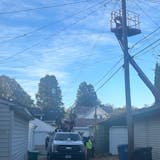Ellen Dick had already survived a winter sleeping under bridges and near the railroad tracks in downtown Minneapolis without falling into relapse. It had been 11 months since she had touched a drug of any kind, her longest stretch in years.
Yet the 43-year-old mother of six said she recalled feeling "an overwhelming desire to get high" last month within hours of arriving at a sprawling homeless encampment in south Minneapolis, where drug overdoses are an almost daily occurrence. The sight of so many users and dealers, some calling out what drugs they had to offer, unleashed her old cravings as she struggled to pitch a tent in the driving rain.
"All I could think was, it would be so easy to get high right now and make all the stress go away," Dick said.
Dick is among dozens of women and men struggling with addiction who face the formidable challenge of staying sober at a homeless camp where squalid conditions and rampant drug use heighten the dangers of relapse. They came seeking refuge from the stress and violence of living on the streets, only to find themselves immersed in the sights and sounds of the very lifestyles they are trying to escape. Inhabitants here say the intense conditions at the camp — including the frequent blare of ambulance sirens, the sight of people overdosing and the daily struggle to stay warm amid the frigid temperatures — can induce sudden stress and trigger a relapse.
Homeless outreach workers estimate that up to a third of the estimated 200 people now living at the camp have histories of substance use but are struggling to stay on the path to recovery.
"It takes incredible strength and character and resilience to stay sober in that environment, which should be celebrated," said Patina Park, executive director of the Minnesota Indian Women's Resource Center in Minneapolis, which provides support groups and treatment services for women struggling with addiction. "Temptations are everywhere."
The campsite that began early this summer with a couple dozen tents on a narrow strip of land near the Little Earth housing project has swelled into a small tent city complete with a community billboard, canvas teepees with campfires, on-site medical care and daily meals animated by ceremonial drumming, songs and prayer. There are entire sections of the camp inhabited by multigenerational Indian families who share food, blankets and clothing by day while watching over one another at night. And their numbers continue to grow: new tents blanket nearly every square foot of the encampment and are now close to spilling into the busy traffic on E. Franklin Avenue.
"This is our Standing Rock," said Desi Gokey, 54, a musician who lives in a small tent near the center of the camp. "You can get stronger out here if you learn how to push away all the negative spirits."


